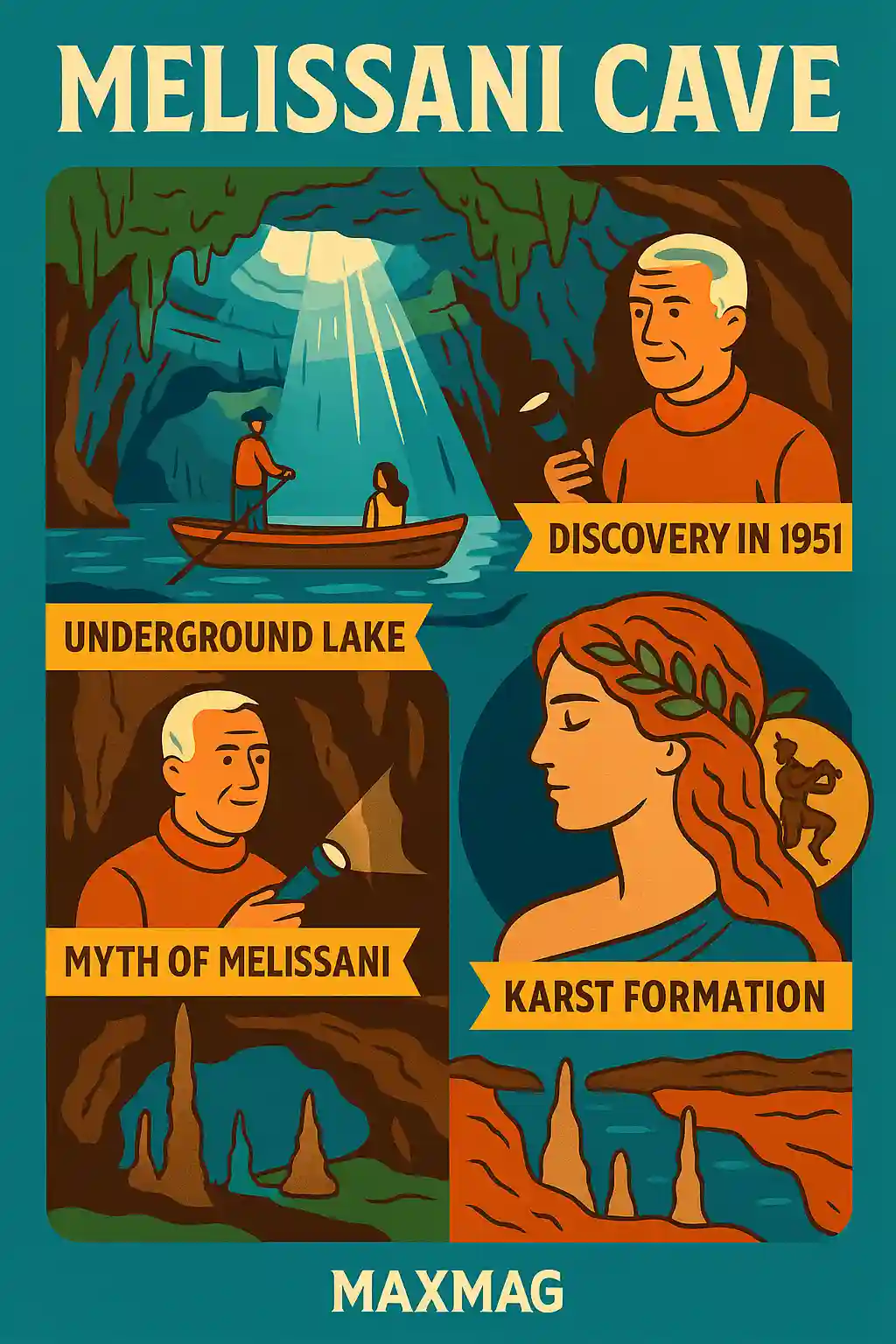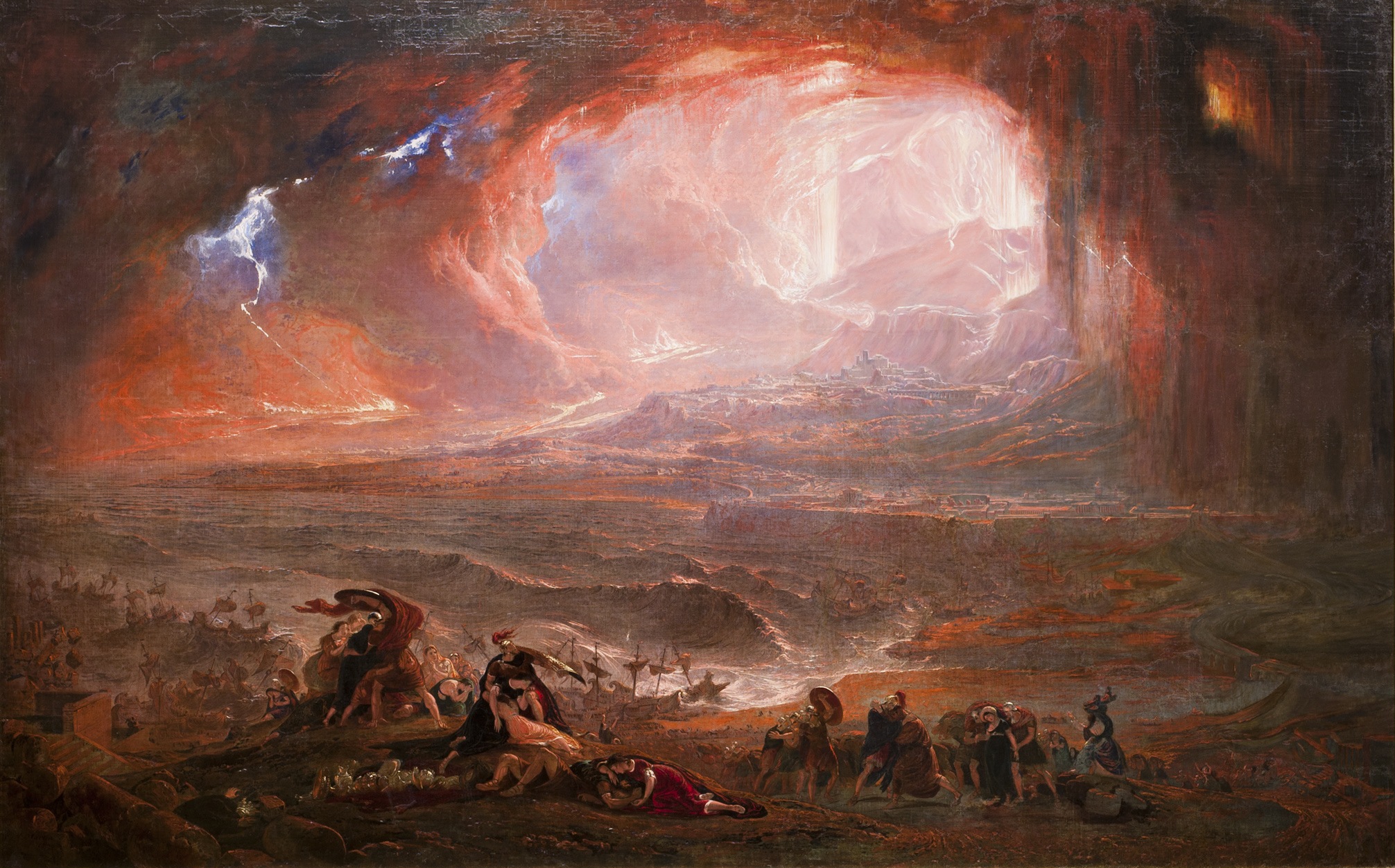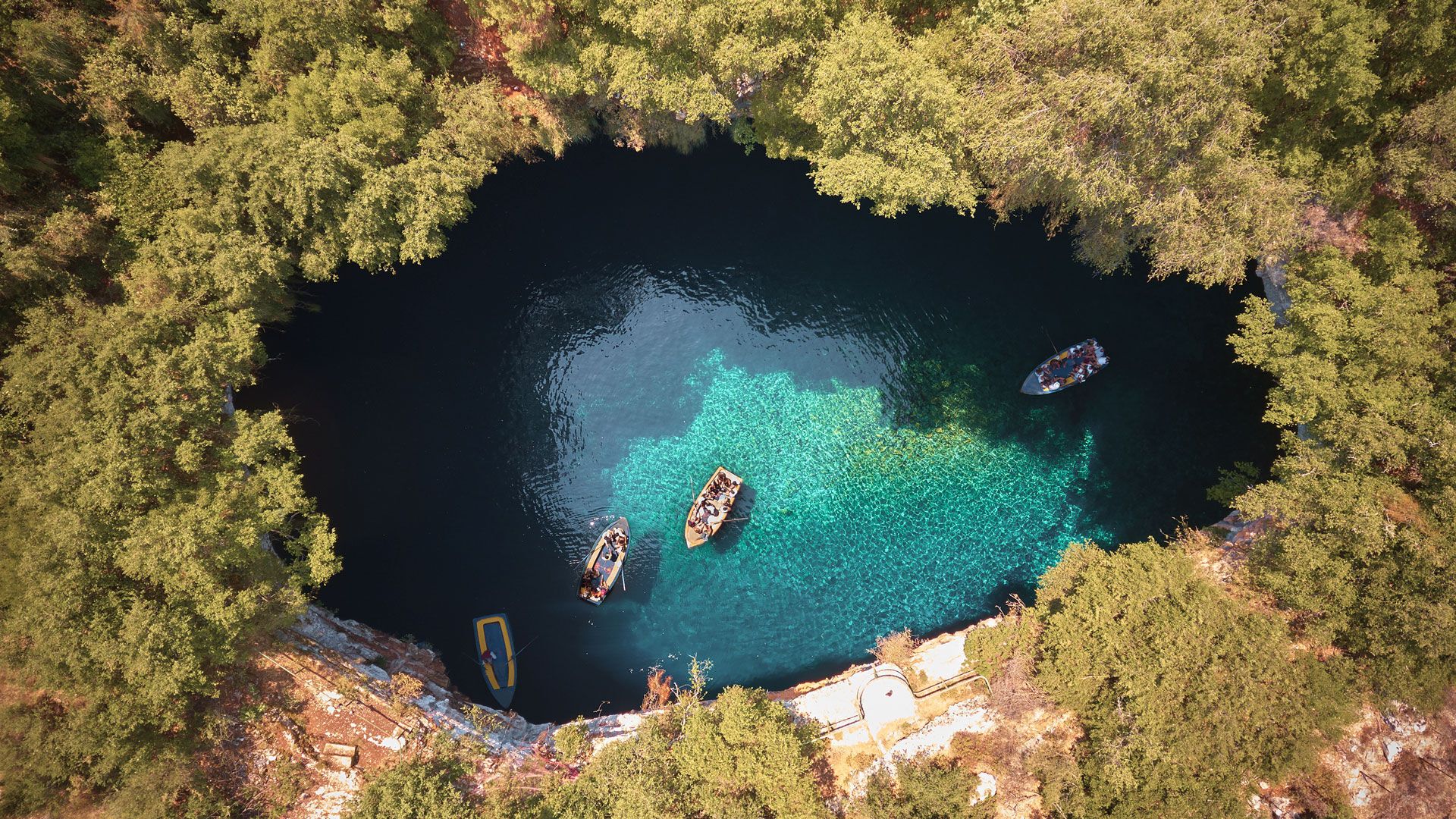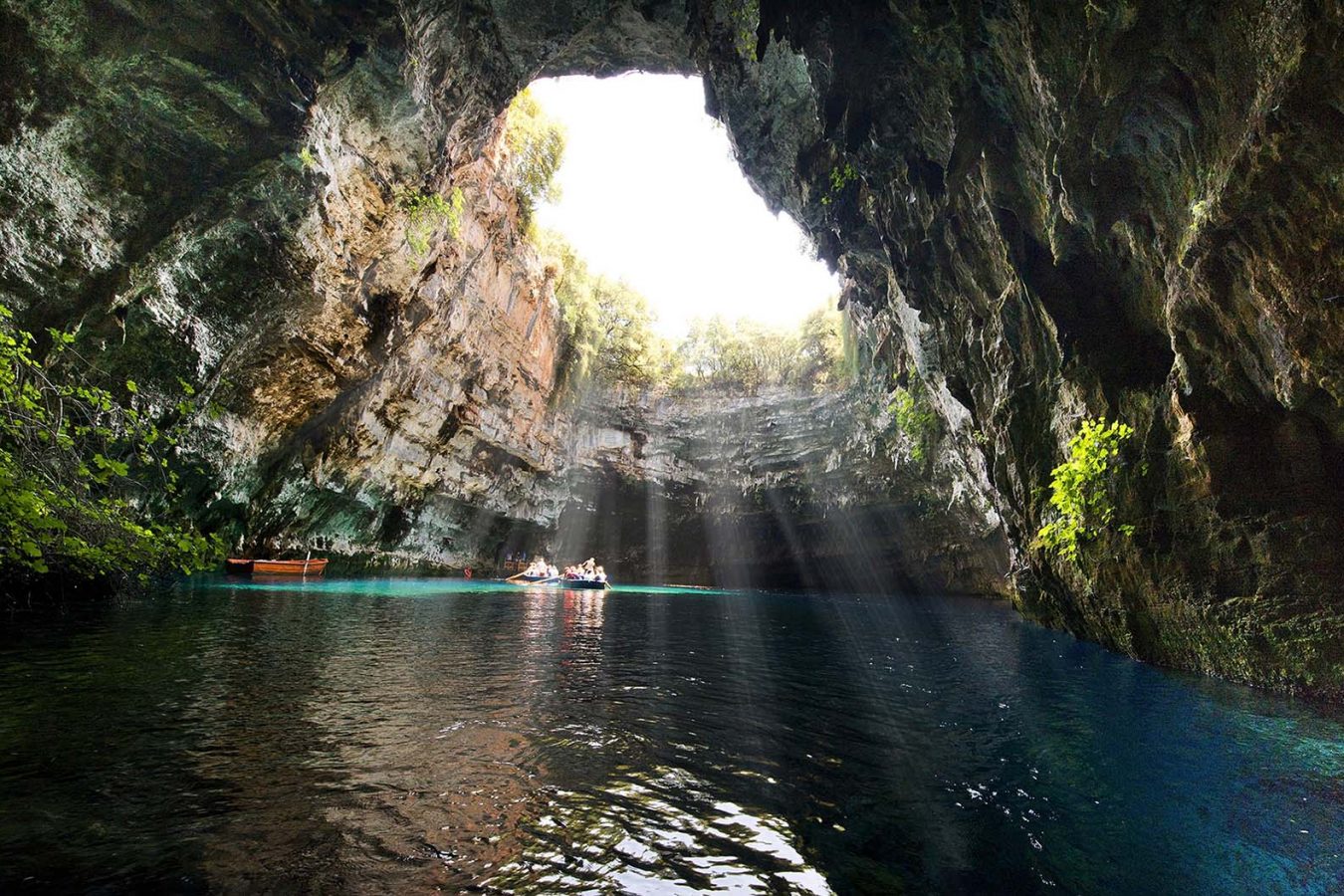
Nestled in the heart of Kefalonia, the largest of the Ionian Islands, lies a place where sunlight dances on turquoise waters, and ancient myths echo through stone corridors. Melissani Cave is more than a natural wonder—it is a living legend shaped by time, water, and human imagination. Revered by the ancient Greeks and admired by modern travelers, Melissani is both a geological marvel and a cultural treasure.
With a crystalline underground lake, partially collapsed ceiling, and a mythical backstory involving nymphs and gods, Melissani Cave is one of Greece’s most unique and captivating destinations. Its allure lies not only in its breathtaking appearance but also in the layers of history, mythology, and science hidden beneath the surface.
The Accidental Discovery That Unveiled a Mythic World
Though known locally for centuries, Melissani Cave was officially rediscovered in 1951 by Greek speleologist Giorgos Petrocheilos. The cave had remained largely unexplored until part of its roof collapsed, revealing a spectacular lake glowing with hues of sapphire and jade as sunlight poured in. This collapse created a cenote-like opening that forever changed the cave’s appearance and appeal.
The lake, formed by both fresh water and infiltrated seawater, immediately captivated scientists and tourists alike. By 1962, archaeological excavations confirmed that this was no ordinary cave—it had been used in antiquity, possibly for ceremonial purposes.
Today, visitors descend a narrow tunnel and board small rowboats that glide silently across the water’s surface. For many, it feels like floating through a sacred temple of nature.
Geological Origins: Carved by Water, Time, and Collapse
The genesis of Melissani Cave is rooted in the island’s karstic landscape. Over thousands of years, slightly acidic rainwater dissolved soluble limestone, gradually carving subterranean cavities. The cave is approximately 160 meters long, 40 meters wide, and 36 meters high, and features a 30-meter-deep lake at its base.
A fascinating feature of Melissani is its dual water sources:
-
Freshwater filtered through the porous limestone of the island
-
Seawater from the western coast, which enters through underground channels
These two types of water mix in the cave without fully blending, creating a shimmering effect that changes depending on the angle and intensity of sunlight.
This hydrological system is so unique that it has been studied extensively in international environmental reports, including by the US Geological Survey, which lists karst caves like Melissani as key formations for understanding aquifer dynamics.
Light and Reflection: The Optical Illusion of the Gods
One of the most magical aspects of Melissani Cave is the natural light show that occurs around midday. When the sun reaches its zenith and beams through the collapsed roof, the water reflects the light upward, illuminating the walls and ceiling in a surreal display of colors. The lake appears to glow from within—a natural phenomenon that has made Melissani one of the most photographed sites in Greece.
Photographers and filmmakers often compare the cave to a cathedral of light. Its intense blues and greens give it an almost supernatural quality, inspiring poets, painters, and tourists alike.
This visual effect is due in part to the clarity of the water, the white limestone beneath the lake, and the precise geometry of the cave’s opening, which filters light in dazzling patterns.
The Mythology of Melissani: Where Nymphs Weep
The cave owes much of its mystical atmosphere to its mythological backstory. In ancient Greek mythology, Melissani was a nymph who fell hopelessly in love with the god Pan. When her feelings were not returned, she drowned herself in the cave’s waters, giving it the name Cave of the Nymphs (Spilia ton Nymfon).
Pan, the god of nature, wild places, and music, was often associated with secluded grottoes and caves—making Melissani an ideal setting for his lore. Archeological finds from the 1962 excavation support the myth’s connection to worship practices. Artifacts include:
-
A clay figurine of Pan
-
A circular disc showing dancing nymphs
-
Oil lamps and ritual objects from the Hellenistic period
These items indicate that the cave was more than just a hiding place; it was likely a sacred sanctuary used for rites dedicated to Pan and the water nymphs.
Inside the Cave: What to Expect on Your Visit
Visiting Melissani Cave is an unforgettable experience. After purchasing a ticket, visitors enter a short man-made tunnel that leads to a stone platform at the lake’s edge. From there, small rowboats accommodate up to 10 people per trip.
The boat ride lasts about 15 minutes and includes two main chambers:
-
The Sunlit Chamber
With its collapsed ceiling and radiant water, this chamber is where the iconic photos are taken. The interplay of light, rock, and water creates a near-mystical atmosphere. -
The Dark Chamber
A quieter, more introspective space with towering stalactites, echoing acoustics, and evidence of ancient human use. Guides sometimes shine flashlights to reveal underwater rock formations and fossils.
A Living Hydrological Puzzle: Katavothres and the Underground River
One of the most fascinating features of Melissani Cave is its role in the island’s hydrological system. In a phenomenon known as the Katavothres Effect, seawater enters sinkholes on the western coast of Kefalonia, travels underground for over 15 kilometers, and re-emerges on the island’s eastern side—partly into Melissani Cave.
This journey takes roughly two weeks and is made possible by a system of underground aquifers and fissures, making the cave a point of interest for environmental scientists and civil engineers. Dye tests in the 1960s confirmed this path, shocking even the local population.
Such systems are rare worldwide and place Melissani among the most intriguing karst caves on the planet.
Cultural and Ecological Preservation: A Delicate Balance
Melissani Cave is protected under Greek national heritage laws and is part of multiple ecological preservation initiatives. Strict measures are in place to maintain its fragile ecosystem:
-
Limited daily visitors during peak season
-
No swimming, smoking, or flash photography
-
Regular monitoring of water quality and air temperature
-
On-site personnel trained in environmental conservation
These efforts are supported by EU and international collaborations to safeguard Melissani as a cultural and natural monument for future generations.
A Star of Tourism: Kefalonia’s Shining Jewel
Melissani Cave attracts over 120,000 visitors annually and has been featured in international travel documentaries, including segments by National Geographic and The Smithsonian Channel. It is often listed among the top 10 natural wonders of Greece, and it rivals attractions like the Blue Caves of Zakynthos or the Samaria Gorge in Crete.
Its popularity has had economic benefits for the region, encouraging sustainable tourism and infrastructure development. However, the local authorities have been careful to balance tourism with preservation, ensuring that Melissani remains unspoiled.
Travel publications such as Lonely Planet consistently rank the cave as a “must-see destination” for anyone exploring the Ionian Islands.
Spirituality, Symbolism, and Cultural Echoes
Beyond its physical beauty, Melissani Cave holds deep spiritual significance. The themes of unrequited love, nature worship, and death-and-rebirth cycles resonate with various traditions across the Mediterranean.
Some modern mystics consider it a sacred energy site, while others see it as an ancient meditation space. The mirrored lake, echoing walls, and soft light give the cave an aura of sanctity, often prompting moments of quiet reflection among visitors.
This fusion of natural harmony and emotional intensity helps explain the enduring fascination with Melissani across cultures and centuries.
Nearby Attractions and Pairing Suggestions
To get the most out of your visit, consider exploring other nearby landmarks on the same day:
-
Drogarati Cave: Just 3 km from Melissani, this vast cave boasts a concert chamber with excellent acoustics.
-
Antisamos Beach: Famous for its crystal-clear waters and lush green surroundings, ideal for a post-cave swim.
-
Sami Village: Offers tavernas, traditional sweets, and harbor views—great for a relaxing lunch.
-
Karavomilos Lake: Part of the same hydrological network, this small inland lake connects directly to the Melissani system.
A Link to the Sacred Caves of Greece
Melissani Cave belongs to a broader network of mysterious and sacred caves in Greece. From the Cave of Zeus in Crete to the subterranean cities of Cappadocia and the underground churches of Meteora, Greece’s caves are not just geographical features—they are stories carved in stone.
For a broader look into these hidden wonders, check out our article on Greece’s miraculous caves, where Melissani stands proudly among the nation’s most spiritually and visually awe-inspiring locations.
❓ Expanded FAQ: Everything You Need to Know
Q1: Can I book tickets online for Melissani Cave?
No, tickets are purchased on-site. Arrive early during peak season to avoid long queues.
Q2: What’s the best time of day to visit?
Around noon (11:30 AM – 1:00 PM) when sunlight streams directly into the cave, creating its famous glow.
Q3: Is Melissani Cave open year-round?
No. It typically operates from April to October, with closures in winter due to weather conditions and conservation efforts.
Q4: Are guided tours available?
Yes, though the boatmen themselves often serve as informal guides, providing brief but informative overviews.
Q5: How long does the visit take in total?
Including waiting time, the entire visit may take 30–45 minutes, making it easy to pair with nearby attractions.
Q6: Are there facilities on-site?
Yes—restrooms, a small café, and souvenir shops are located near the cave entrance.
Q7: Is the site accessible to people with disabilities?
Unfortunately, due to stairs and narrow pathways, the cave is not wheelchair accessible.
Q8: Is Melissani safe for children and seniors?
Absolutely. Life vests are available, and the boats are very stable.






